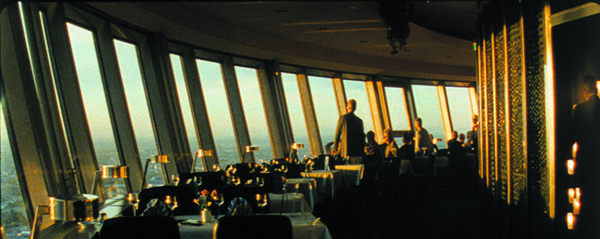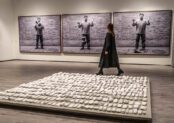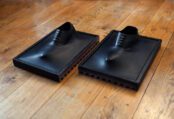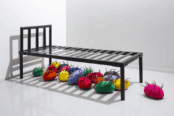Light, or more specifically, its fading is a recurring presence in Tacita Dean’s films as is rotational or circular movement, both serving as indicators of time – actual, cinematic and psychological, coming together in unconventional framings of familiar scenes.
In Disappearance at Sea (1996), for example, the film captures close-ups of the rotating lighthouse bulbs whilst the distant horizon is only glimpsed through the glass. Fernsehturm is similar in its focus on the restaurant’s interiors; we see the ‘main view’ only from a sideways perspective, and through the gestures of diners pointing outwards.
Fernsehturm was shot in one afternoon in October, 2001 during Dean’s year-long DAAD fellowship with the Berlin Artist-in-Residence program. As with many of her films, Dean used 16mm film and an anamorphic lens to achieve a long rectangular view that enables a wide perspective of the spherical interiors of Berlin TV-tower restaurant and its curved wall of windows. The work records the transition from day to night whilst the space itself gradually rotates 360 degrees.
‘Like the perpetual rotation of the spacecraft in Stanley Kubrick’s 2001: A Space Odyssey, a conceit to maintain gravity on board ship, the Fernsehturm restaurant continues to turn almost imperceptibly like the movement of the planets in Space. It was visionary in its concept and a symbol of the future, and yet it is out of date. The Fernsehturm embodies the perfect anachronism…As you sit up there at your table, opposite the person whom you are with, and with your back to the turn of the restaurant, you are no longer static in the present but moving with the rotation of the Earth backwards into the future,’ wrote Dean (2000).
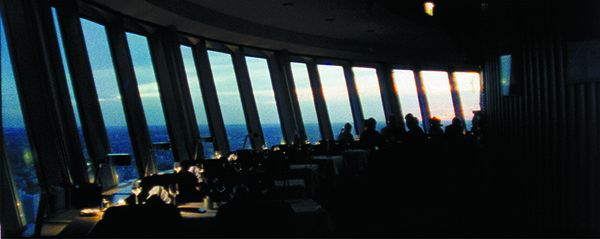
In the opening few minutes, as the camera holds steady on the empty tables, our eyes search for points of recognition, things to hold onto that we can give shape to and categorise, but the persistence of the shot has the effect of inciting the imagination, so that the image begins to waver, uncertain and amorphous. The familiar becomes strange, incongruous.
As with many of Dean’s films, there isn’t a prescribed narrative; we’re watching the natural unfolding of time and everything else is incidental. People’s bodies cross in front of the lens, and occasionally, we get little glimpses of other spaces – the bar, the doorway into the WC, a ridged wall surface. In comparison to fast-paced Hollywood action, nothing really happens at all. But things are happening; the space is moving, slowly, and the sun, on its progression beneath the horizon, leaves lingering traces, licking golden up the walls, illuminating the liquid inside glasses, cutting through silhouettes in strong, white lines.
The light is what alters our perspective of the space not the camera; the camera is merely the guide. It is in many ways a process of revelation. That is to say, the light shows us what’s already there by altering the balance of our perception. At around four minutes, for example, the space brightens suddenly, revealing the brilliant blue of the menus, the peach coloured flowers on the table and the fan formation of the teal napkins. At 16 minutes, the camera closes in on a group of diners as they’re bathed in ethereal light. It’s a moment of extraordinary, transient beauty that goes by seemingly unnoticed by the people in the restaurant – the waiters continue their work, and the diners are fixated on the external view (it’s the reason they chose the restaurant, after all) – and as the camera draws back to the other side of the space, where the light is less intense, there’s a small sense of something lost.
Whilst the film is full of sound (voices, things being lifted, glasses and plates clanging), it is the silence beneath that resonates, an almost tangible softness. And this is where the true power of the piece lies: it extends our perception, allowing us to see beyond the present and into a kind of eternal space that’s made possible only by the distance that film provides. We can see and hear the scene, but our presence within it is like the light itself: disembodied, floating, spectral.
‘Fernsehturm‘ (2001) by Tacita Dean is currently available to view for free on Marian Goodman Gallery’s website: mariangoodman.com/tacita-dean-fernsehturm.
An essay examining the use of chalk in Tacita Dean’s drawings features in the current issue of Trebuchet, available to purchase via: trebuchet-magazine.myshopify.com/collections/materials/Materials
Featured image: Tacita Dean, Fernsehturm, 2001, film still, 16 mm colour anamorphic film, optical sound, 44 minutes. Courtesy the artist; Marian Goodman Gallery, New York/Paris and Frith Street Gallery, London
Reference: Tacita Dean, Museu d’Art Contemporani de Barcelona (MACBA), Barcelona, 2000

Millie Walton is a London-based art writer and editor. She has contributed a broad range of arts and culture features and interviews to numerous international publications, and collaborated with artists and galleries globally. She also writes fiction and poetry.

